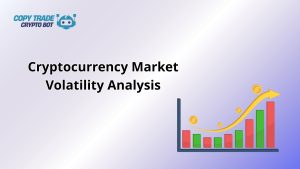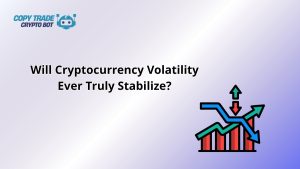Table of Contents
- 1 What Is Cryptocurrency Market Volatility Analysis?
- 2 Why Volatility Is So Important in Crypto
- 3 The Main Causes Behind Crypto Market Volatility
- 4 Top Metrics for Cryptocurrency Market Volatility Analysis
- 5 Volatility Trends in 2025: What’s Different This Year?
- 6 How Media and Sentiment Influence Volatility
- 7 Practical Tips for Navigating Crypto Volatility
- 8 Advanced Volatility Analysis for Pro Traders
- 9 Will Cryptocurrency Volatility Ever Truly Stabilize?
- 10 Where Does the Crypto Market Go From Here?
What Is Cryptocurrency Market Volatility Analysis?

Cryptocurrency market volatility analysis refers to the process of assessing and interpreting price fluctuations within the digital asset market. In 2025, as the crypto sector matures, this analysis has become a core part of decision-making for traders, investors, and institutions alike.
Cryptocurrencies are known for their rapid and unpredictable price changes. While this creates profitable trading opportunities, it also introduces significant risk. Cryptocurrency market volatility analysis provides insights into what causes these price swings and how they impact market participants.
By understanding the patterns, triggers, and metrics of market volatility, traders can form strategies that not only protect capital but also optimize profit potential.
Why Volatility Is So Important in Crypto
Volatility is a defining feature of crypto markets. Unlike traditional assets, cryptocurrencies can swing 5–10% in a single day, or even within a few hours. This makes cryptocurrency market volatility analysis a vital skill for anyone involved in the space.
Volatility isn’t inherently bad—it represents movement, and movement means opportunity. However, without proper analysis, traders may act emotionally, leading to poor decisions. That’s why understanding the drivers of volatility is critical.
The Main Causes Behind Crypto Market Volatility
To conduct effective cryptocurrency market volatility analysis, we need to examine the main factors that drive volatility. Here are the most prominent ones in 2025:
Speculative Investor Behavior
Cryptocurrency markets are still heavily driven by speculation. Retail traders and short-term investors often react impulsively to news, rumors, and market trends. This causes price spikes and drops that can seem irrational.
Regulatory Announcements
Changes in crypto regulations can cause sharp market reactions. In 2025, new frameworks in the U.S., Europe, and Asia have already influenced investor behavior. Any positive or negative update can trigger immediate volatility.
Cryptocurrency market volatility analysis must consider regulatory factors as high-impact volatility triggers.
Market Liquidity and Depth
Many altcoins still lack deep liquidity. When large buy or sell orders hit the market, they can cause extreme price shifts. Even large-cap coins like Bitcoin and Ethereum can experience illiquidity during high-stress periods.
Volatility analysis often includes order book assessments and volume metrics.
Macroeconomic Conditions
Global interest rates, inflation, geopolitical tensions, and economic downturns impact all financial markets, including crypto. In 2025, macroeconomic instability continues to amplify crypto volatility.
Any comprehensive cryptocurrency market volatility analysis must include macroeconomic overlays.
Top Metrics for Cryptocurrency Market Volatility Analysis
![]()
Analyzing volatility requires using specific technical indicators and metrics. Below are the key tools traders use in 2025:
Historical Volatility (HV)
Historical volatility shows how much a cryptocurrency’s price has changed over a specific time. It gives context for how “normal” or “abnormal” recent volatility is.
This metric is a core component of cryptocurrency market volatility analysis.
Implied Volatility (IV)
Derived from options pricing, implied volatility reflects future expectations. If IV spikes, traders are anticipating bigger price swings.
In crypto derivatives trading, IV is used to predict potential breakouts or crashes.
Average True Range (ATR)
ATR measures how much an asset moves, on average, during a specific time period. A high ATR means high volatility. Many traders use ATR to set stop-losses.
For accurate cryptocurrency market volatility analysis, ATR offers a reliable short-term volatility signal.
Bollinger Bands
Bollinger Bands widen or contract based on volatility. When bands expand, it indicates a rise in volatility, which often precedes large price movements.
This indicator is especially useful in sideways or consolidation phases.
Crypto Volatility Index (Crypto VIX)
Modeled after the traditional VIX, this index measures expected volatility in the crypto market. It’s especially useful for macro-level cryptocurrency market volatility analysis.
Volatility Trends in 2025: What’s Different This Year?
The Role of Institutional Capital
The influx of institutional investors—pension funds, hedge funds, and asset managers—has changed volatility patterns. While institutions bring stability, their large trades can create systemic shocks.
When analyzing volatility, we must consider the impact of institutions exiting or entering the market rapidly.
Integration of AI and Bots in Trading
AI-driven trading bots dominate large volumes of market activity in 2025. These bots react to news sentiment, price action, and technical setups at high speed.
Their presence increases volatility during peak news cycles, making cryptocurrency market volatility analysis even more data-driven.
More Sophisticated Retail Investors
Retail investors in 2025 are more educated, with access to advanced tools. As a result, herd behavior is less chaotic—but still exists.
Volatility spikes often still occur around events like airdrops, hard forks, or earnings announcements for token-based projects.
How Media and Sentiment Influence Volatility
Social Media Impact on Market Swings
Platforms like X (Twitter), Discord, and Telegram often ignite major market moves. A viral tweet can send a coin soaring—or crashing.
Smart traders include sentiment monitoring in their cryptocurrency market volatility analysis, using AI tools to track real-time mood shifts.
The Influence of News Cycles
Crypto never sleeps. News can break at any time, affecting the market instantly. Whether it’s a hack, exchange outage, or partnership announcement, traders must stay alert.
News-based volatility is one of the hardest to predict—but also offers high-reward trading opportunities if timed right.
Use Tight Risk Management Rules
Position sizing, stop-losses, and proper capital allocation are your first defense. No cryptocurrency market volatility analysis is complete without action-oriented strategies.
Stay Updated With Data Tools
Use platforms like CoinGlass, CryptoQuant, or Santiment to access real-time volatility metrics and whale activity.
Diversify Across Assets and Strategies
Don’t rely on just one coin or one method. Diversifying strategies and assets reduces exposure to sudden volatility shocks.
Trade With the Trend, Not Against It
If the market is trending upward during a high-volatility period, ride the wave but manage exit points wisely. Going against strong trends can amplify losses.
Advanced Volatility Analysis for Pro Traders
Professional traders and analysts go deeper into cryptocurrency market volatility analysis by incorporating:
- On-chain analytics: Whale movements, exchange flows, and dormant token activity.
- Derivatives market data: Futures open interest, funding rates, and liquidations.
- Sentiment algorithms: Using NLP to scan forums and social media for emotional extremes.
Combining these layers creates a more robust picture of future volatility potential.
Will Cryptocurrency Volatility Ever Truly Stabilize?

This is a hot topic in 2025. Some argue that as adoption increases, the market will behave more like traditional finance—less volatile, more predictable.
Others believe the crypto market’s innovation pace and decentralized nature will always create volatile cycles.
So, where does cryptocurrency market volatility analysis go from here?
Expect more tools, more automation, and deeper AI integration. But no tool will replace the need for human interpretation and risk discipline.
Where Does the Crypto Market Go From Here?
With AI trading, evolving regulations, and institutional involvement reshaping the landscape, one thing is clear: cryptocurrency market volatility analysis will remain a critical skill.
The question isn’t whether volatility will disappear—but how well you can analyze and adapt to it.
So, as we look forward—are you ready for the next big volatility wave?
